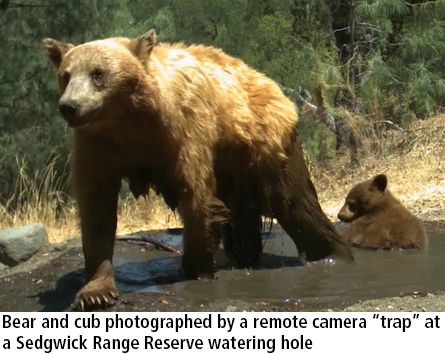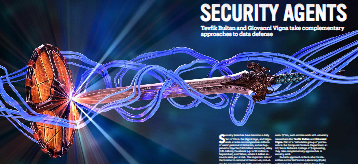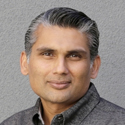Research Overview

Computer Engineering Research at UCSB
CE research lies not only at the interface of computer science and electrical engineering, but increasingly ties computing together with biology, medicine, chemistry, physics, mechanical engineering, and even environmental engineering.
Our research is ideally positioned to help solve societal problems through the construction of practical systems composed of emerging technologies. We live in a time of both opportunity and crisis. Rising carbon emissions and energy costs are a global problem. Aging populations increasingly strain healthcare resources. Computing technologies are at the heart of many potential solutions to these problems. Emerging technologies in nanoscale and bio-compatible materials hold the promise to increase energy-efficiency and revolutionize healthcare. We also see opportunities in massive information gathering and large-scale computing resources to exploit that information.
We must also address increasing challenges to continued scaling of conventional silicon and to maintaining the dramatic performance growth of past computing systems.
CE Areas of Research
- Bioinspired Computing
- Circuit and System Design
- Computer Architecture
- Electronic Design Automation & Testing
- Emerging Technologies for Computing
- Energy-efficient Computing
- Nanotechnology
- Operating and Distributed Systems
- Software and Language
COE Convergence – "Where's the Bear?"
UCSB RACELab: Professors Chandra Krintz and Rich Wolski

Millions of images of animals — mountain lions, black bears, deer, and many other species of interest — have been captured by camera traps on the 6,000-acre Sedgwick Ranch Reserve, part of UC Santa Barbara’s Natural Reserve System. The images are a treasure trove of information that could be immensely useful to land managers and ecologists, but most remain stored on hard drives — unsorted, uncatalogued, inaccessible, and, thus, unused.
Now a system created by UCSB computer science professors Chandra Krintz and Rich Wolski, aptly named “Where’s the Bear?” is bringing machine learning to the task of identifying and classifying animals caught on camera.
Assigning to computers a vexing task that until now was the sole purview of people saves enormous manpower — what once took fourteen days to do can now be done in three hours — and the approach has potential far beyond Sedgwick to other reserves, and beyond ecology to agriculture and even medical imaging.
Where’s the Bear works well, notes Krintz, vice chair of UCSB’s undergraduate program in computer science. “We don’t get any coyotes wrong. We don’t get any bears wrong. We get about 12-percent error on deer — there are lots of deer — and we are trying to improve on that. Now, all the ecologists are saying, ‘Count deer, count bear. Tell me if the bear is healthy. Is it the same bear, is it the same deer? How many deer are there with antlers?’”
Where’s the Bear integrates recent advances in machine-learning-based image processing to automatically classify animals in images captured by remote, motion-triggered camera traps. So far, the system has helped the Sedgwick team aggregate and analyze more than 1 million images. And because the hardware lives at Sedgwick, all the data processing is done within yards of where the data is collected.
Read the full article in Convergence "Where's the Bear?"
COE 2019 Convergence – "Security Agents"

Computer Science Professors Tevfik Bultan and Giovanni Vigna take complementary approaches to data defense
Security breaches have become a daily fact of life in the Digital Age, and large-scale attacks can compromise millions of users’ personal information, as has happened at Equifax (143 million accounts), eBay (145 million), Facebook (up to 50 million in September), and Yahoo, where 3 billion accounts were put at risk. The important role of the Internet in national infrastructure, including the power grid, air-traffic-control systems, and financial networks, has made it the target of sophisticated attacks as well.
Digital security break-ins cost approximately $109 billion in the United States in 2016, and are estimated to cost between $375 billion and $575 billion per year worldwide. Small wonder that governments and industry are committing enormous resources to gain the upper hand in the data-theft wars. Often, such entities work with university researchers like Tevfik Bultan and Giovanni Vigna. Part of a formidable group of professors in the Computer Science Department, they take complementary approaches to security work.
Bultan’s approach reflects what he describes on his Verification Laboratory (VLab) website as “an ongoing shift in focus from performance to dependability,” reflecting the fact that “the size and complexity of the software systems nowadays inevitably lead to errors during both design and implementation phases” — errors that can cause vulnerabilities that compromise data.
Faculty Research News
Professor Tevfik Bultan awarded a half million dollar NSF grant

Bultan is the sole Principal Investigator for the three year award for verification and repair of access control policies for cloud-based software services.
Prof. Luke Theogarajan and others from UCSB work together in "Shrinking the Synthesizer"
 Theogarajan part of a team that has produced significant advances in chip-based integrated photonics and nonlinear optics that enable miniature, energy-efficient components for an optical synthesizer. Their findings appear in the journal Nature.
Theogarajan part of a team that has produced significant advances in chip-based integrated photonics and nonlinear optics that enable miniature, energy-efficient components for an optical synthesizer. Their findings appear in the journal Nature.
Prof. Rich Wolski named the Duval Family Presidential Chair in Energy Efficiency at UCSB
 Wolski was named the campus’s inaugural holder of the chair among UCSB Institute for Energy Efficiency researchers pursuing solutions that reduce energy use associated w/ cooling loads, inefficient server use and wasteful computer processes.
Wolski was named the campus’s inaugural holder of the chair among UCSB Institute for Energy Efficiency researchers pursuing solutions that reduce energy use associated w/ cooling loads, inefficient server use and wasteful computer processes.